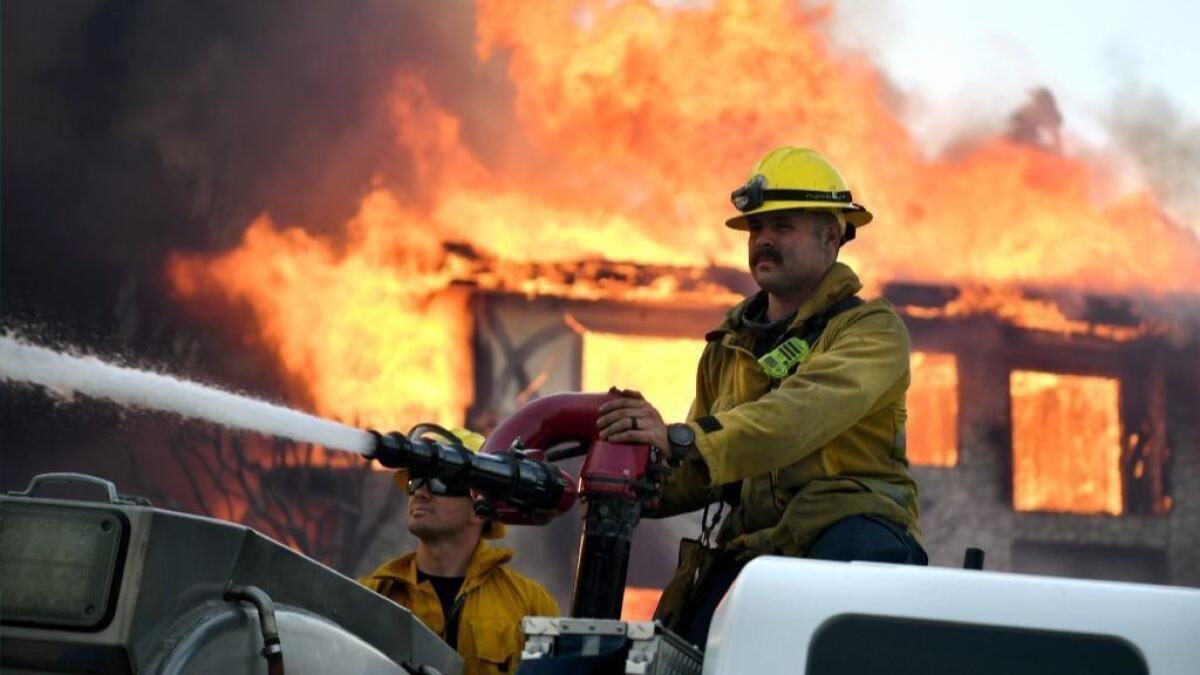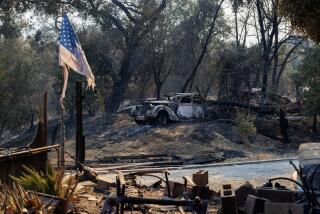Column: How to deal with an insurer after your home is burned down

The vast majority of California homeowners have insurance that covers fire damage. But that doesn’t mean you can breathe easy.
Property insurance lawyers say it’s not uncommon for insurers to do everything possible to minimize payouts, especially after catastrophic blazes such as the ones now raging in Northern and Southern California.
“In a mass loss, they’re looking at their overall payments,” said Joshua Haffner, a Los Angeles lawyer specializing in fire-related claims. “They’ll do what they can to keep payments down. And they’re getting very smart about paying less.”
He said many homeowners may not be aware that property insurers have been slipping provisions into people’s policies limiting coverage for damage caused by smoke and ash.
In major fires, hundreds or even thousands of homes may be consumed by flames. But thousands more can be damaged in large and small ways by plumes of smoke and ash traveling for miles beyond the burn zone.
Some policies may require homeowners to report any such damage within 90 days to qualify for coverage. Others may cap coverage at a certain level, frequently $5,000.
Such provisions often are inserted into policies during routine renewals. Although all changes must be disclosed, many homeowners may not pay attention or may not read the fine print.
“People have to be very vigilant,” Haffner told me.
Then there’s the matter of whether the coverage you’ve purchased is sufficient to accommodate increases in material and labor costs. Experts say underinsurance is one of the most common issues as homeowners try to recover and rebuild after a huge fire.
Amy Bach, executive director of the advocacy group United Policyholders, said her organization estimates that as many as two-thirds of California homeowners may not have enough coverage for a catastrophic fire.
“Chances are, you’ll be short,” she said.
Bach advised all homeowners to contact their insurance company and arrange for a policy review based on the latest information about fire risk.
The insurance industry says that, like a good neighbor (as the jingle goes), it will be there once the flames have been doused.
“For people with legitimate claims, the insurance industry will pay legitimate claims,” said Mark Sektnan, vice president of state government relations for Property Casualty Insurers Assn. of America, an industry group.
However, he noted that fire-related damage is increasing every year. Last year, Sektnan said, the industry faced a record $12 billion in claims resulting from California fires.
These soaring claims are resulting in higher rates statewide.
“We should anticipate that when the risk is increasing, insurers will price to that risk,” Sektnan said.
He said limits on claims for smoke and ash were put in place because some lawyers would encourage homeowners to seek compensation well after the fact.
“We’re not going to rebuild somebody’s house because they had smoke damage three years before,” Sektnan said.
All experts agree: It’s up to homeowners to make sure they have sufficient coverage for their property. If you live in a high-risk area, such as near a canyon, it’s wise to pay more for additional coverage — if you can get it.
Some insurers have exited the California property market, seeing it as too costly to cover. Others may charge rates for high-risk areas that are too pricey for many people.
Homeowners who can’t find affordable coverage in the open market may have to turn to a state-sponsored program called the California FAIR Plan.
FAIR covers up to $1.5 million for a residential structure and its contents, which in some cases won’t be enough for full replacement of a lost home and property.
Meanwhile, replacement costs you locked in for your insurance policy may no longer reflect current conditions. Thanks to President Trump’s tariffs, for example, steel and concrete may be more expensive than anticipated.
Then there’s what the industry calls “demand surge,” which is when contractors and building-supply businesses start jacking up prices because, well, supply and demand.
“When there’s a catastrophe, there’s definitely going to be increases in costs,” said Michelle Smythe, a Pasadena property lawyer.
She said it’s up to insurance agents to anticipate this when writing new policies for clients, but the buck stops with the homeowner, who bears final responsibility to make sure enough coverage has been purchased.
Smythe advised to always go with higher estimates. In other words, if you’re told it will cost $200 per square foot to rebuild your house, insure yourself for at least $300 per square foot.
Also, ask your broker about what’s known as an extended replacement cost endorsement. This is additional coverage intended to accommodate at least a portion of unexpected cost increases.
You can also purchase extra coverage for code upgrades. For example, the rules might have changed for electrical systems or insulation since your house was built.
Code-upgrade insurance will protect you from so-called betterments that your basic policy might not address.
This is very important: Take your smartphone and walk around your home shooting a video of all your belongings. Such a record can be invaluable if an insurer disputes, say, that you owned a state-of-the-art home-theater setup.
If you have to evacuate, save all receipts. Many homeowner policies include so-called ALE coverage, as in “additional living expenses,” which will include costs such as hotel rooms, food and rentals.
For more information, you can reach out to the state Department of Insurance via its consumer hotline: (800) 927-4357.
David Lazarus’ column runs Tuesdays and Fridays. He also can be seen daily on KTLA-TV Channel 5 and followed on Twitter @Davidlaz. Send your tips or feedback to [email protected].
More to Read
Inside the business of entertainment
The Wide Shot brings you news, analysis and insights on everything from streaming wars to production — and what it all means for the future.
You may occasionally receive promotional content from the Los Angeles Times.











